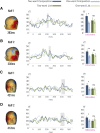Simple composition: a magnetoencephalography investigation into the comprehension of minimal linguistic phrases
- PMID: 21414902
- PMCID: PMC6623787
- DOI: 10.1523/JNEUROSCI.5003-10.2011
Simple composition: a magnetoencephalography investigation into the comprehension of minimal linguistic phrases
Abstract
The expressive power of language lies in its ability to construct an infinite array of ideas out of a finite set of pieces. Surprisingly, few neurolinguistic investigations probe the basic processes that constitute the foundation of this ability, choosing instead to focus on relatively complex combinatorial operations. Contrastingly, in the present work, we investigate the neural circuits underlying simple linguistic composition, such as required by the minimal phrase "red boat." Using magnetoencephalography, we examined activity in humans generated at the visual presentation of target nouns, such as "boat," and varied the combinatorial operations induced by its surrounding context. Nouns in minimal compositional contexts ("red boat") were compared with those appearing in matched non-compositional contexts, such as after an unpronounceable consonant string ("xkq boat") or within a list ("cup, boat"). Source analysis did not implicate traditional language areas (inferior frontal gyrus, posterior temporal regions) in such basic composition. Instead, we found increased combinatorial-related activity in the left anterior temporal lobe (LATL) and ventromedial prefrontal cortex (vmPFC). These regions have been linked previously to syntactic (LATL) and semantic (vmPFC) combinatorial processing in more complex linguistic contexts. Thus, we suggest that these regions play a role in basic syntactic and semantic composition, respectively. Importantly, the temporal ordering of the effects, in which LATL activity (∼225 ms) precedes vmPFC activity (∼400 ms), is consistent with many processing models that posit syntactic composition before semantic composition during the construction of linguistic representations.
Figures






References
-
- Allen M, Badecker W, Osterhout L. Morphological analysis in sentence processing: an ERP study. Lang Cognit Process. 2003;18:405–430.
-
- Awh E, Jonides J, Smith EE, Schumacher EH, Koeppe RA, Katz S. Dissociation of storage and rehearsal in verbal working memory: evidence from positron emission tomography. Psychol Sci. 1996;7:25–31.
-
- Badre D, Wagner AD. Left ventrolateral prefrontal cortex and the cognitive control of memory. Neuropsychologia. 2007;45:2883–2901. - PubMed
-
- Badre D, Poldrack RA, Paré-Blagoev EJ, Insler RZ, Wagner AD. Dissociable controlled retrieval and generalized selection mechanisms in ventrolateral prefrontal cortex. Neuron. 2005;47:907–918. - PubMed
-
- Bavelier D, Corina D, Jezzard P, Padmanabhan S, Clark V, Karni A, Prinster A, Braun A, Lalwani A, Rauschecker J, Turner R, Neville H. Sentence reading: a functional MRI study at 4 tesla. J Cogn Neurosci. 1997;9:664–686. - PubMed
Publication types
MeSH terms
LinkOut - more resources
Full Text Sources
Other Literature Sources
